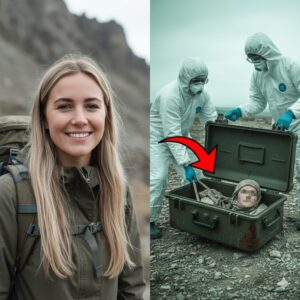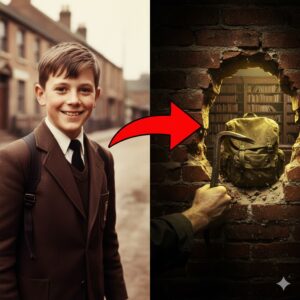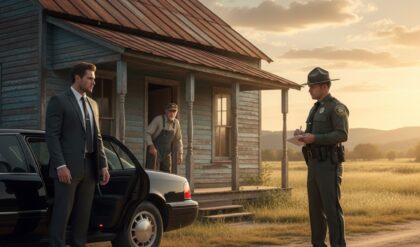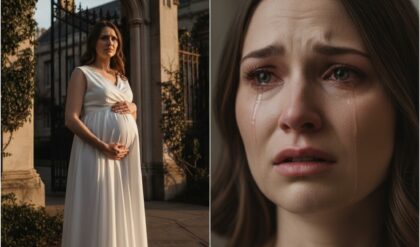UNVEILED: THE FACE OF A MEDIEVAL HERO FROM 1361 – SCIENTISTS BRING A 14TH-CENTURY WARRIOR BACK TO LIFE
In a remarkable fusion of history, science, and art, a team of European researchers has achieved what once seemed impossible: they have reconstructed the face of a warrior who fought and died nearly 700 years ago. Dating back to the year 1361, during one of the bloodiest chapters of medieval Europe, this warrior’s story is now being told through his bones—and his newly revealed face.
For centuries, he was just another forgotten casualty of war. But now, this nameless knight has become a symbol of courage, strength, and the incredible power of modern science to resurrect the past.
A SKELETON IN THE EARTH, A STORY IN THE BONES
The journey began in 2022, when archaeologists excavating a mass grave near Visby, Sweden, stumbled upon the remarkably preserved remains of a man who appeared to have died in battle. The site was identified as part of the Battle of Visby, a brutal conflict that took place in July 1361 between invading Danish forces and the defenders of the Swedish island of Gotland.
Unlike other skeletons found at the site, this one was unique. The bones suggested a man in his mid-30s, physically robust, with well-developed muscle attachments that indicated years of training and combat. The multiple healed injuries and fatal head wound told a story of a seasoned warrior who died defending his homeland.
“He was clearly no ordinary soldier,” said Dr. Erik Norlund, lead archaeologist on the project. “He fought hard, likely survived many battles, and died with honor. We wanted to give him his identity back.”
THE SCIENCE OF RESURRECTION: REBUILDING A FACE FROM 1361
In partnership with forensic artists and 3D modeling experts, the team used advanced craniofacial reconstruction techniques to rebuild the warrior’s appearance. The process included:
-
CT scans of the skull to digitally reconstruct muscle and tissue layers
-
Forensic reconstruction based on age, ancestry, and physical characteristics
-
Artistic input to recreate skin tone, hair texture, and era-appropriate features
The result? A lifelike, hauntingly human portrait of a 14th-century fighter, complete with a strong jaw, high cheekbones, and determined eyes.
“It was like meeting someone from the past face to face,” said forensic artist Anna Grethe. “He’s no longer a skeleton in a museum. He’s a person again.”
MORE THAN BONES: A GLIMPSE INTO MEDIEVAL LIFE
Beyond the face, researchers also recreated his likely armor, clothing, and weapons based on artifacts found at the site. He was likely a well-trained militia member, equipped with chainmail, a nasal helmet, and a long sword.
His injuries—deep cuts to the skull and leg—suggest he died in close combat, possibly overwhelmed by more heavily armed Danish invaders.
“His story reflects the brutal nature of medieval warfare,” said Dr. Norlund. “But it also shows the resilience and bravery of those who stood against invasion.”
WHY THIS MATTERS: HISTORY WITH A HUMAN FACE
This reconstruction isn’t just a scientific achievement—it’s an emotional and educational breakthrough. It allows the public to connect on a deeply personal level with history, to see not just dates and battles, but the faces of real people who lived, fought, and died.
The face of the 14th-century warrior is now on display at the Gotland Museum, where visitors stand in awe before the portrait of a man who died defending his home nearly 700 years ago. Schoolchildren, historians, and tourists alike are finding new inspiration in the way science can bridge the centuries.
“We often think of the medieval world as distant and primitive,” said museum curator Lena Karlsson. “But this face reminds us—it was full of people like us. With families. With fears. With incredible bravery.”
CONCLUSION: A WARRIOR REMEMBERED
For centuries, this man lay forgotten beneath the soil of a Swedish battlefield. But now, through the tools of 21st-century science, his courage, sacrifice, and humanity are remembered.
The warrior may have died in 1361—but today, his face lives on, a timeless tribute to the resilience of the human spirit and the power of modern discovery.
News
Tourist Disappeared in Ardennes — 3 Years Later His Body Found in Box Wrapped in Plastic…
Tourist Disappeared in Ardennes — 3 Years Later His Body Found in Box Wrapped in Plastic… Imagine a quiet place, a tourist camp in the dense forests of Belgium, families with children, tourists, laughter around the campfires. Now imagine that…
In 1966 a child disappeared, 50 years later his backpack was found on the wall of the Library.
In 1966 a child disappeared, 50 years later his backpack was found on the wall of the Library. The day the schoolboy disappeared was a quiet autumn day in 1966. He left school after school around noon and was on…
My Children Excluded Me From Dinner, I Started Laughing And I Asked The Owner For A Table, Because The Owner..
My Children Excluded Me From Dinner, I Started Laughing And I Asked The Owner For A Table, Because The Owner.. My children scheduled a family dinner at the most exclusive restaurant in the city, but when I arrived there was…
A taxi driver who took a pregnant woman to the hospital for free… and then she…
A taxi driver who took a pregnant woman to the hospital for free… and then she… A taxi driver who took a pregnant woman to the hospital for free… and then her… It was a rainy night, one of those…
After my husband m.u.r.i.ed, I kicked his stepson out of the house — 10 years later, a truth came to light that nearly destroyed my entire being.
After my husband m.u.r.i.ed, I kicked his stepson out of the house — 10 years later, a truth came to light that nearly destroyed my entire being. “Go away. You’re not my son. My wife is dead. I have no…
A 70 year old mother came to her son to borrow money for medical treatment, but her son only gave her a pack of noodles and then politely sent her home. When she got home and opened it, she was shocked by what was inside.
The 70-Year-Old Mother Knocked on Her Son’s Door to Borrow Money for Surgery — He Only Handed Her a Pack of Instant Noodles. But When She Opened It at Home, She Froze in Tears. It was late afternoon in rural Texas,…
End of content
No more pages to load











